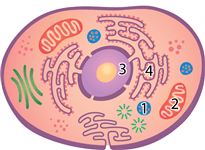
Test 1 Review
Quiz by Amanda Wood
Feel free to use or edit a copy
includes Teacher and Student dashboards
Measure skillsfrom any curriculum
Measure skills
from any curriculum
Tag the questions with any skills you have. Your dashboard will track each student's mastery of each skill.
With a free account, teachers can
- edit the questions
- save a copy for later
- start a class game
- automatically assign follow-up activities based on students’ scores
- assign as homework
- share a link with colleagues
- print as a bubble sheet
21 questions
Show answers
- Q1Cells obtain energy from organic compounds and transfer it to the energy used to drive the chemical reactions in the cell in which of these organelles?342130s
- Q2Which cellular process would be affected first if the structure labeled 3 were destroyed?respirationphotosynthesisreproductiontransport30s
- Q3Which of the following statements is not true?Water is polar.Water is the most abundant molecule in the Earth’s atmosphere.Water is essential for life.Water stabilizes temperature.30s
- Q4Which type of isomers are represented in the following image?Geometric isomersNone of the aboveStructural isomersEnatiomers30s
- Q5If xenon has an atomic number of 54 and a mass number of 108, how many neutrons does it have?100542710830s
- Q6A student put some drops of Lugol’s iodine solution into the water in the beaker shown above. The water turned red. After a short time, the starch solution inside the dialysis tubing turned black. Which function of the cell membrane was the student demonstrating?diffusion through a permeable membranefacilitated diffusion of starchdiffusion through a semipermeable membraneactive transport of hydrogen ions30s
- Q7Which of the following substances must be taken into the cell by the structure above labeled 3 because it is too large to pass through the cell membrane?glucosesodiumpolysaccharidepotassium30s
- Q8The energy that comes from organic compounds is transferred to the cell to maintain healthy function. Which organelle in an animal cell is responsible for this energy transfer?ribosomescytoplasmnucleusmitochondria30s
- Q9Which cellular process takes place in the ribosomes that are bound to the endoplasmic reticulum?The replication of nucleic acidsThe synthesis of new proteinsThe conversion of radiant energy to glucoseThe breakdown of waste material30s
- Q10This diagram shows cellular activity across a cell membrane.Which two processes does this diagram most directly model?Homeostasis and transport of moleculesEnergy conversions and synthesis of new moleculesSynthesis of new molecules and homeostasisTransport of molecules and energy conversions30s
- Q11Plant cells are much less flexible than animal cells. Which cellular structure in plant cells is most responsible for this characteristic?cell wallchloroplastcell membranevacuole30s
- Q12What is the function of the cell wall in a plant cell?control the functions of the cellgenerate the cell's supply of energycontain waste products of the cellprovide structural support and protection30s
- Q13Prokaryotes are single-celled organisms belonging to the Domains: Archae and Bacteria. Which of the following cell structures would not be present in prokaryotic cells?cell membranenucleuscytoplasmribosome30s
- Q14Carbohydrates are more easily metabolized than lipids. However, on a gram-for-gram basis lipids provide cells with more —nitrogenenergyproteinsstructure30s
- Q15Which of the following biomolecules typically contains both nitrogen and phosphate?ProteinNucleic acidLipidCarbohydrate30s
